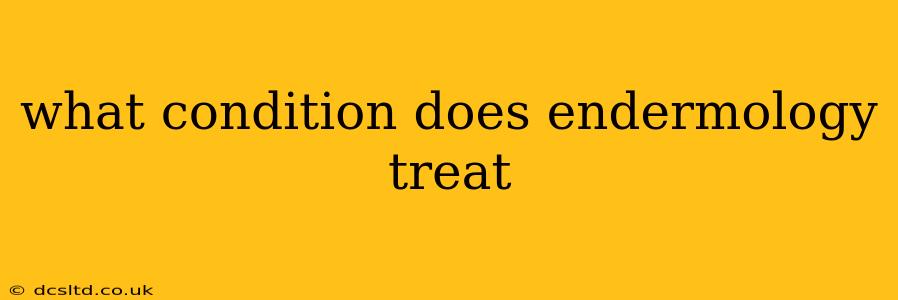Endermology, a non-invasive body contouring treatment, is used to address a variety of aesthetic concerns. While not a weight-loss solution, it effectively targets cellulite, improves skin texture, and reduces localized fat deposits. This article delves deeper into the specific conditions Endermology can treat and addresses common questions surrounding this popular procedure.
What is Endermology?
Before exploring the conditions Endermology treats, let's briefly define the procedure. Endermology utilizes a specialized device with motorized rollers and suction cups that gently massage the skin. This mechanical stimulation encourages lymphatic drainage, improves blood circulation, and stimulates collagen production. This multifaceted approach addresses several aesthetic concerns simultaneously.
What Conditions Does Endermology Treat?
Endermology is primarily used to treat:
-
Cellulite: This is arguably the most common reason people seek Endermology. The treatment's mechanical action helps break down fibrous bands contributing to the dimpled appearance of cellulite, smoothing the skin's surface. The improved circulation also helps reduce the appearance of orange-peel skin.
-
Localized Fat Deposits: While not a weight-loss solution, Endermology can effectively reduce stubborn pockets of fat that resist diet and exercise. The massage action helps to break down fat cells and stimulate their natural elimination through the lymphatic system. It's important to note that this is most effective in conjunction with a healthy lifestyle.
-
Skin Tightening and Improved Texture: The stimulation of collagen production contributes to firmer, smoother skin. Endermology can improve skin tone and reduce the appearance of sagging skin, particularly in areas like the thighs, buttocks, and abdomen.
-
Lymphatic Drainage: The massage action promotes lymphatic drainage, which can help reduce fluid retention and swelling. This can be beneficial for individuals experiencing post-surgical edema or those prone to water retention.
Does Endermology Treat Lipedema?
What is Lipedema?
Lipedema is a chronic, painful condition characterized by excessive fat deposits predominantly in the legs, hips, and buttocks. It differs from simple obesity as it affects the subcutaneous tissue (just beneath the skin) and is often disproportionate to the rest of the body.
Endermology's Role in Lipedema Management
While Endermology isn't a cure for lipedema, it can be a valuable component of a comprehensive management plan. It can help to reduce swelling, improve lymphatic drainage, and temporarily improve the appearance of the affected areas. However, it's crucial to consult with a healthcare professional specializing in lipedema to develop a personalized treatment approach. Endermology should be considered one tool among many, potentially including manual lymphatic drainage, compression therapy, and lifestyle modifications. It's vital to understand that Endermology alone won't address the underlying causes of Lipedema.
Can Endermology Treat Diastasis Recti?
Diastasis recti is the separation of the abdominal muscles (rectus abdominis) that often occurs during pregnancy. While Endermology can improve the appearance of the abdomen by slightly tightening the skin and potentially improving tone, it does not directly treat the muscle separation itself. Specific exercises and physical therapy are recommended for addressing diastasis recti. Consulting a physical therapist or pelvic floor specialist is vital for appropriate management and rehabilitation.
Is Endermology Painful?
Most people describe the sensation as a firm massage, rather than painful. However, individual sensitivity varies. Some may experience mild discomfort or bruising, particularly during initial sessions. This usually subsides quickly.
How Many Endermology Treatments Are Needed?
The number of treatments varies depending on individual needs and goals. A typical course of treatment might range from 6 to 12 sessions, with sessions usually spaced a few days or a week apart. Maintenance treatments may be recommended to sustain results.
This information is for general knowledge and does not constitute medical advice. Always consult a qualified healthcare professional before undergoing any medical or aesthetic procedure. They can help determine if Endermology is appropriate for your individual needs and circumstances.
